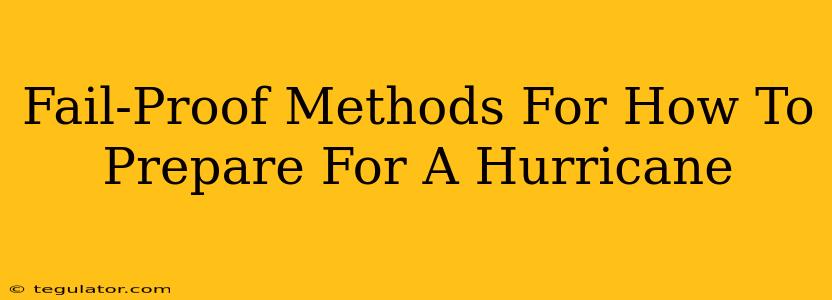Hurricane season is no joke. Knowing how to prepare for a hurricane can mean the difference between weathering the storm relatively unscathed and facing a devastating aftermath. This guide provides fail-proof methods to ensure you and your loved ones are as safe as possible.
Before the Storm: Proactive Steps to Hurricane Preparedness
1. Develop a Family Communication Plan:
- Establish a meeting point: Designate a location both inside and outside your home where everyone can regroup in case of separation.
- Choose an out-of-state contact: Designating a person outside the affected area ensures a reliable communication channel if local lines are down.
- Share important information: Make sure everyone has a list of emergency contacts, insurance information, and medical details.
2. Create a Hurricane Supply Kit:
- Water: Stock up on at least one gallon of water per person per day for at least three days.
- Food: Non-perishable items are key—think canned goods, energy bars, and dried fruit. Don't forget a can opener!
- First-aid kit: A comprehensive kit should include bandages, antiseptic wipes, pain relievers, and any personal medications.
- Flashlights and batteries: Opt for LED flashlights as they last longer and are more energy-efficient.
- Radio: A battery-powered or hand-crank radio is crucial for receiving weather updates.
- Important documents: Keep copies of insurance policies, identification, and other crucial papers in a waterproof bag.
- Cash: ATMs might be unavailable, so having cash on hand is vital.
- Comfort items: For children, pack favorite toys or blankets to help reduce stress.
3. Secure Your Home:
- Trim trees and shrubs: Debris from overgrown vegetation can cause significant damage during high winds.
- Reinforce windows: Consider using plywood or storm shutters to protect your windows from flying debris.
- Bring in loose objects: Secure anything that could become airborne—patio furniture, garbage cans, etc.
- Protect your car: Park it in a garage or away from trees and power lines.
4. Know Your Evacuation Route:
- Identify evacuation zones: Understand whether you live in an evacuation zone and familiarize yourself with designated routes.
- Plan your escape: Know the quickest and safest route out of your area, keeping traffic patterns in mind.
- Practice your plan: Conduct a mock evacuation to identify potential issues and ensure everyone knows the plan.
During the Hurricane: Staying Safe
- Stay indoors: The safest place to be during a hurricane is inside a sturdy structure, ideally away from windows.
- Monitor weather updates: Keep your radio on to stay informed about the storm's progression.
- Avoid flooded areas: Never drive or walk through floodwaters—they can be deceptively deep and fast-moving.
- Conserve resources: Ration your food and water to make them last.
After the Hurricane: Recovery and Rebuilding
- Check for injuries: Assess yourself and your family for any injuries and seek medical attention as needed.
- Report damage: Contact your insurance company and local authorities to report any damage to your property.
- Avoid downed power lines: Downed power lines are extremely dangerous—stay away from them at all costs.
- Be aware of potential hazards: Be cautious of broken glass, debris, and other potential hazards.
By following these fail-proof methods, you can significantly increase your chances of surviving a hurricane with minimal damage and stress. Remember, preparation is key! Don't wait until the last minute; start planning today.

